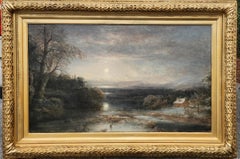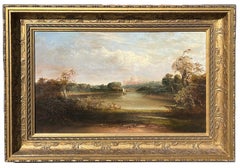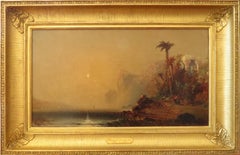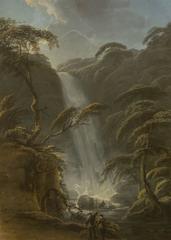Thomas Doughty Art
American, 1793-1856
Born in Philadelphia, Thomas Doughty was the first American artist to work exclusively as a landscapist and was successful both for his skill and the fact that Americans were turning their interest to landscape. He was known for his quiet, often atmospheric landscapes of the rivers and mountains of Pennsylvania, New York, especially the Hudson River Valley, and New England.
A criticism of his work was that "there was often more of Doughty in his landscapes than there was of the location he painted." His landscapes were popular early in his career, but he was surpassed by Thomas Cole and other Hudson River painters in the view of a public that wearied of his work that was perceived as "over-mannered and too unspecific compared to that of his successors."
Doughty was trained in leather manufacturing but turned to art as leisure activity and received only three months of training in India-ink drawing. In 1820, he turned to art completely, and by 1822, was exhibiting at the Pennsylvania Academy of Fine Arts and two years later was elected an academician. In 1827, he was elected an honorary member of the National Academy of Design.
He was also a creative lithographer, and from 1830 to 1834, published with his brother a monthly journal called Cabinet of Natural History and American Rural Sports. In this publication, birds and animals were drawn precisely with landscape backgrounds by Doughty.
Doughty spent much of his life in Baltimore, Washington, Boston, and New York City, but for much of the time made his home in Philadelphia until 1832 when he moved to Boston. After five years in Boston, he went to England for two years. On his return to America in 1838, Doughty lived for a time in New York City, but in 1839-40 he was at Newburgh, New York on the Hudson River.
He returned in 1841 to New York City, where he remained, except for a second trip to Europe (1845-46) and a brief residence in western New York (1852-54), until his death, whose date is uncertain. Some give his death date as 1856, but census records indicate he was still alive in 1860. He spent the last 20 years of his career in New York City.(Biography provided by Lincoln Glenn)
to
1
3
3
3
1
1
1
Overall Height
to
Overall Width
to
1
1
3
3
6,961
3,321
2,514
1,213
2
2
2
2
1
Artist: Thomas Doughty
Evening on the Schuylkill River, near Philadelphia
By Thomas Doughty
Located in Jacksonville, FL
Provenance:
Alexander Gallery, NYC 1985
Manoogian Collection, Detroit, MI
Private Collection, Great Neck, NY
Exhibitions:
Alexander Gallery, NYC "Hudson River Masters" 1986
Rau Ant...
Category
19th Century Thomas Doughty Art
Materials
Canvas, Oil
Windsor Castle by Hudson River Artist Thomas Doughty (American, 1793-1856)
By Thomas Doughty
Located in New York, NY
Windsor Castle, a painting by Hudson River School artist Thomas Doughty (1793-1856) is oil on canvas and measures 17.13 x 27.63 inches. The work is signed by the artist at the lower ...
Category
19th Century Hudson River School Thomas Doughty Art
Materials
Canvas, Oil
1830's Hand-colored Lithograph of a Ground Squirrel
By Thomas Doughty
Located in Soquel, CA
Wonderfully preserved hand-colored 1830's lithograph "Ground Squirrel" by Thomas Doughty (American, 1793 - 1856), circa 1830. From "The Cabinet of Natural History and American Rural Sports." Phila: J.&T. Doughty, 1830-32. Sold previously by Bland Gallery, Early 20th century East Side gallery specializing in miniatures. Presented in frame with new acid-free mat under plexiglass. Image size: 7.25"H x 8.75"W.
Doughty’s short-lived magazine “The Cabinet of Natural History and American Rural Sports” is an important imprint in the history of American printing. It contained the first colored sporting prints made in America. Issued in monthly parts and published from the end of 1830 until the spring of 1834, “The Cabinet” featured articles on hunting, detailed descriptions of newly discovered flora and fauna, and some of the finest examples of early American hand-colored lithography. It was originally the work of the Doughty brothers, Thomas and John, with virtually all of the plates being the work of Thomas, who also founded the Hudson River School. But, by the spring of 1832, the partnership had broken up and Thomas had moved to Boston. An abbreviated third volume lacked Thomas’ touch.
Printed by Childs & Inman, the partnership between Philadelphia engraver and lithographer Cephas G. Childs and New York portrait...
Category
1830s Realist Thomas Doughty Art
Materials
Ink, Paper
Related Items
On The Mohawk
By William Ongley
Located in Saratoga Springs, NY
Signed lower right.
A landscape and marine painter, William Ongley was born in England in 1836 and came to America with his family and settled in New York. His art studies took him ...
Category
Late 19th Century Hudson River School Thomas Doughty Art
Materials
Oil, Canvas
"Greek Ruins"
By Franklin D. Briscoe
Located in Lambertville, NJ
Signed Lower Right
Known for his marine, history, and portrait paintings, Franklin Briscoe was born in Baltimore, Maryland and at age four moved with his family to Philadelphia where he later became a student of Edward Moran and where eventually he settled his studio.
Briscoe made extended ocean voyages, including trips to Europe where he saw much painting in galleries, and from these adventures and observations developed his landmark paintings of the ocean and ships in all kinds of weather conditions.
In 1885, he painted an historical mural that was in ten panels, a total of 230 feet long, and 13 feet tall--"The Battle of Gettysburg...
Category
19th Century Hudson River School Thomas Doughty Art
Materials
Canvas, Oil
Winter Moonlight
By George William Sotter
Located in Lambertville, NJ
signed lower right
Category
1910s American Impressionist Thomas Doughty Art
Materials
Canvas, Oil
New York Landscape
Located in Milford, NH
A fine New York landscape with cows by American artist Emile Faure Beaulieu (b. 1828, actively exhibiting in the 1850-1860’s). Beaulieu was known as...
Category
1850s Hudson River School Thomas Doughty Art
Materials
Canvas, Oil
"Sunday in the Park, 1910"
By Cyprien Eugène Boulet
Located in Lambertville, NJ
Signed Lower Right
Cyprien-Eugène Boulet (1877 - 1927)
Category
Early 20th Century Impressionist Thomas Doughty Art
Materials
Canvas, Oil
The Harvest
Located in London, GB
Farmhands working in a field on a hot summer's day.
Building on iconic depictions of farmworkers by Millet, Huys sought to imbue his figures with a sensitivity and reverence that ...
Category
20th Century Thomas Doughty Art
Materials
Canvas, Oil
"In Port"
By Edward Willis Redfield
Located in Lambertville, NJ
Jim’s of Lambertville is proud to offer this artwork by:
Edward Willis Redfield (1869 - 1965)
Edward W. Redfield was born in Bridgeville, Delaware, moving to Philadelphia as a young child. Determined to be an artist from an early age, he studied at the Spring Garden Institute and the Franklin Institute before entering the Pennsylvania Academy from 1887 to 1889, where he studied under Thomas Anshutz, James Kelly, and Thomas Hovenden. Along with his friend and fellow artist, Robert Henri, he traveled abroad in 1889 and studied at the Academie Julian in Paris under William Bouguereau and Tony Robert-Fleury. While in France, Redfield met Elise Deligant, the daughter of an innkeeper, and married in London in 1893.
Upon his return to the United States, Redfield and his wife settled in Glenside, Pennsylvania. He remained there until 1898, at which time he moved his family to Center Bridge, a town several miles north of New Hope along the Delaware River. Redfield painted prolifically in the 1890s but it was not until the beginning of the twentieth century that he would develop the bold impressionist style that defined his career. As Redfield’s international reputation spread, many young artists gravitated to New Hope as he was a great inspiration and an iconic role model. Edward Redfield remained in Center Bridge throughout his long life, fathering his six children there.
Around 1905 and 1906, Redfield’s style was coming into its own, employing thick vigorous brush strokes tightly woven and layered with a multitude of colors. These large plein-air canvases define the essence of Pennsylvania Impressionism. By 1907, Redfield had perfected his craft and, from this point forward, was creating some of his finest work.
Redfield would once again return to France where he painted a small but important body of work between 1907 and 1908. While there, he received an Honorable Mention from the Paris Salon for one of these canvases. In 1910 he was awarded a Gold Medal at the prestigious Buenos Aires Exposition and at the Panama-Pacific Exposition of 1915 in San Francisco, an entire gallery was dedicated for twenty-one of his paintings.
Since Redfield painted for Exhibition with the intent to win medals, his best effort often went into his larger paintings. Although he also painted many fine smaller pictures, virtually all of his works were of major award-winning canvas sizes of 38x50 or 50x56 inches. If one were to assign a period of Redfield’s work that was representative of his “best period”, it would have to be from 1907 to 1925. Although he was capable of creating masterpieces though the late 1940s, his style fully matured by 1907 and most work from then through the early twenties was of consistently high quality. In the later 1920s and through the 1930s and 1940s, he was like most other great artists, creating some paintings that were superb examples and others that were of more ordinary quality.
Redfield earned an international reputation at a young age, known for accurately recording nature with his canvases and painting virtually all of his work outdoors; Redfield was one of a rare breed. He was regarded as the pioneer of impressionist winter landscape painting in America, having few if any equals. Redfield spent summers in Maine, first at Boothbay Harbor and beginning in the 1920s, on Monhegan Island. There he painted colorful marine and coastal scenes as well as the island’s landscape and fishing shacks. He remained active painting and making Windsor style furniture...
Category
Early 1900s American Impressionist Thomas Doughty Art
Materials
Canvas, Oil
19th Century Hudson River School Landscape after Richard Goodwin
Located in Soquel, CA
Charming Hudson River school antique oil painting of a sailboat on a lake, circa 1880-90. Signed "R. Labarr." after Richard LaBarre Goodwin...
Category
1880s Hudson River School Thomas Doughty Art
Materials
Canvas, Oil
H 10 in W 16 in D 1 in
"Forest Strongholds"
By John F. Carlson
Located in Lambertville, NJ
Signed lower right. Complemented by a hand carved and gilt frame.
Exhibited at the National Academy of Design, 1928
Category
20th Century American Impressionist Thomas Doughty Art
Materials
Canvas, Oil
Vista From West Campton, New Hampshire
By Frederick Williams
Located in Milford, NH
A fine New Hampshire landscape by American artist Frederick Dickinson Williams (1829–1915). Frederick Dickinson Williams was born into a patrician household in Boston, Massachusetts and attended the prestigious Boston Latin School before entering Harvard University in 1846. After graduation and until 1874, Williams taught drawing and painting in the Boston Public School System as a Professor of Drawing until 1874. Williams and his wife, the former Lucia M. Hunt, of Newburyport, relocated to Paris, France, where both studied the new French art and painted landscapes and genre scenes in their studio until 1888, when Lucia died in Paris.
Williams returned to the United States and settled in Boston, opening a studio in late 1888. He continued to paint in the Boston area with regular trips to the White Mountains of New Hampshire and other wilderness areas where he produced a large body of French-inspired landscapes in the manner of Corot and other contemporary French painters. In 1904, a serious fire in his Boston studio destroyed all of his inventory, including a number of award-winning canvases from his Paris sojourn. Despite this significant loss, he continued to paint. During his long and successful career, Williams exhibited his work at the Pennsylvania Academy of Fine Art, the Washington DC Art...
Category
Late 19th Century Hudson River School Thomas Doughty Art
Materials
Oil, Canvas
SWIFT FOX - GREAT PLAINS WINTER
Located in Aventura, FL
Lithograph on paper. Hand signed, titled and numbered by the artist. Edition of 350.
Artwork is in excellent condition. Certificate of Authenticity is included. All reasonable offers will be considered.
About the artist: A wildlife painter whose work often has sparrows, Michael Dumas...
Category
Late 20th Century Realist Thomas Doughty Art
Materials
Lithograph, Paper
Landscape with Cows near Warwick, New York
By Jasper Francis Cropsey
Located in New York, NY
Signed and dated lower left: J. F. Cropsey / 1885
Category
Late 19th Century Hudson River School Thomas Doughty Art
Materials
Oil, Canvas
Previously Available Items
"Landscape with Pine Trees and House, " Thomas Doughty, Hudson River School View
By Thomas Doughty
Located in New York, NY
Thomas Doughty
Landscape with Pine Trees and House, circa 1835
Oil on canvas
22 1/4 x 30 inches
Provenance:
Private Collection, Massachusetts
Shannon's Fine Art Auctioneers, Milford...
Category
1830s Hudson River School Thomas Doughty Art
Materials
Canvas, Oil
Kaaterskill Falls
By Thomas Doughty
Located in Wiscasset, ME
Born in Philadelphia in 1793, Hudson River School artist Thomas Doughty was one of the first American artists devoted to landscape painting and is known for his quiet, atmospheric re...
Category
Mid-19th Century Hudson River School Thomas Doughty Art
Materials
Gouache
Thomas Doughty art for sale on 1stDibs.
Find a wide variety of authentic Thomas Doughty art available for sale on 1stDibs. You can also browse by medium to find art by Thomas Doughty in canvas, fabric, oil paint and more. Not every interior allows for large Thomas Doughty art, so small editions measuring 14 inches across are available. Customers who are interested in this artist might also find the work of Seth Eastman, Joseph Floch, and William Rickarby Miller. Thomas Doughty art prices can differ depending upon medium, time period and other attributes. On 1stDibs, the price for these items starts at $320 and tops out at $24,000, while the average work can sell for $19,500.





